7 Characteristics of an Effective KPI
Many contact center leaders struggle with determining which key performance indicator (KPI) is the right metric to focus on improving customer service, employee engagement, and cost. Figure 1 shows the characteristics and definitions of an effective KPI for determining contact center performance. Using the seven characteristics of an effective KPI is a practice for helping contact center managers select the right metrics for effectively and efficiently managing their contact center.
Figure 1: Characteristics and Definition of an Effective KPI
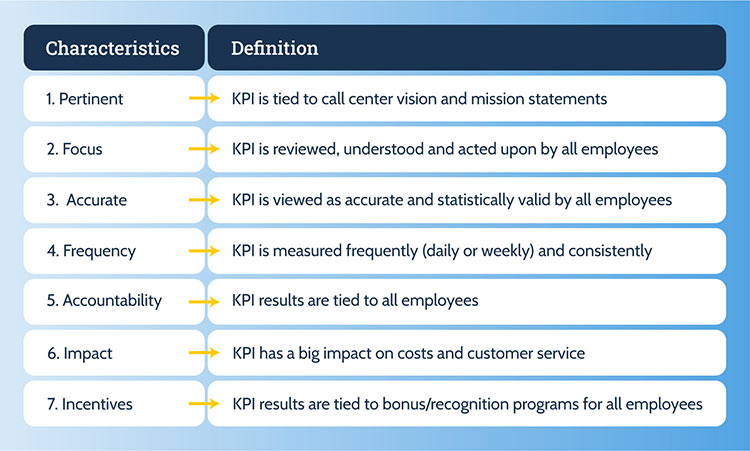
Figure 2 is a grid that shows the contact center's most commonly used KPIs and how many of the seven characteristics each KPI meets. The more characteristics a KPI meets, the greater impact it has on the operation of a contact center. FCR is the only metric that meets all seven characteristics of an effective KPI. For this reason, FCR is viewed by many contact center leaders as the most important metric for determining a contact center's performance.
Figure 2: Common Contact Center KPIs Grid
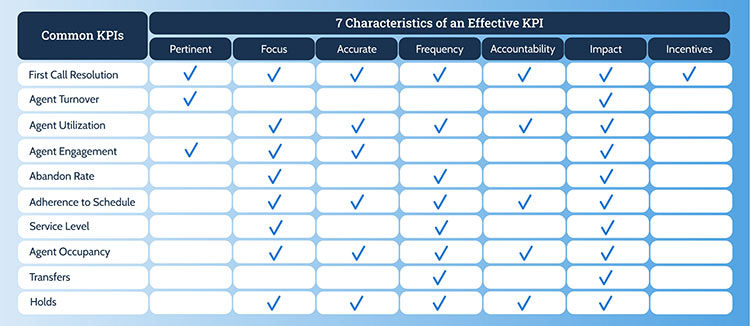
Contact centers have traditionally used operational metrics (e.g., service level, call quality) as KPIs for operating their contact center. Traditional operational metrics are essential; however, they tend to have five or fewer of the seven characteristics of an effective KPI for operating a contact center. For example, service level, which contact center management traditionally ranks as one of the most critical metrics for operating a contact center, meets only three characteristics of an effective KPI (i.e., focus, frequency, and impact). Agents cannot be held accountable for service level, and it is not effective for an Agent incentive program.
Another example is average handle time (AHT), one of the most common traditional operational metrics and meets five characteristics of an effective KPI (i.e., focus, accuracy, frequency, accountability, and impact). However, AHT does not meet the other two characteristics of an effective KPI because it is not pertinent to a contact center's vision and mission and is not an effective metric for an Agent incentive program. Put simply, just because a call is handled quickly does not mean that it is handled effectively. This is especially true if the customer has to call back because the information is incomplete.
Example – Agents not held accountable for AHT
One of SQM's contact center clients in the health insurance sector removed the AHT metric from their list of metrics for which Agents were held accountable. Managers thought that if they held their Agents accountable for calls resolved rather than AHT, the incoming call volume would drop. In order to de-emphasize Agent accountability to AHT, managers removed the reader boards and made AHT accountable at the management level. Almost immediately, call volume dropped by 7%.
Not holding Agents accountable for AHT performance is a best practice unless they are underperforming. In cases where they are underperforming, Agents should be held accountable and coached to improve their AHT performance. The intent here is to de-emphasize Agent accountability for AHT while maintaining practices that protect the contact center's AHT and operating costs.
In today's competitive environment, using traditional operational metrics alone is not enough. Contact centers must place more focus on FCR and Esat to be successful. It is these metrics that deliver the most value to the organization and customers. That being said, contact centers still need to use traditional operational metrics to measure and manage their contact center performance.
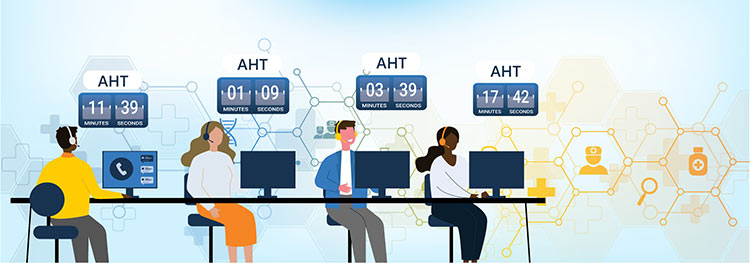
World-class Contact Center Targets for Commonly used KPIs
Based on customer service, FCR, Agent Engagement, and operational benchmarking studies, SQM has determined world-class contact center targets for commonly used KPIs. SQM's contact center benchmarking studies show that only 5% of the contact centers achieved the world-class KPI targets.
Customer Service Metrics
Many senior contact center managers ask SQM the following customer service questions, "What KPIs are most important, what are the world-call targets and what are the best customer service employee accountability KPIs?" SQM's view that only a few of the below world-class customer service targets used for KPIs should be used to create accountability from the Agent to the senior VP level.
The typical voice of the customer (VoC) service metrics used to create accountability from the Agent to the senior VP contact center level are 'FCR,' 'call resolution,' and 'overall customer satisfaction with the contact center or the Agent.' Any of these three metrics meet all seven characteristics of an effective KPI.
The other customer service metrics and targets are worth pursuing and creating accountability at the Agent level. However, they should have less importance for employee accountability at all levels because they have fewer characteristics of an effective KPI. Below are the world-class customer service targets for commonly used KPIs.
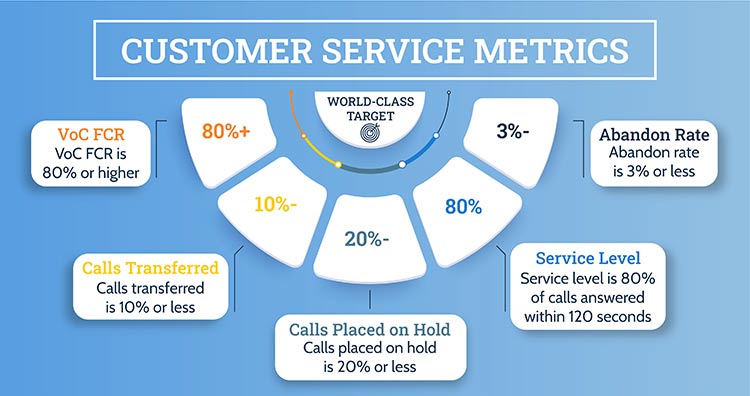
Employee Experience Metrics
Contact centers that handle low to high complexity calls have achieved world-class employee experience performance. However, achieving world-class employee experience metrics is critical for contact centers handling moderate to high complexity calls because the correlation between employee satisfaction (Esat) and FCR/Csat is very high. In other words, high Esat drives high FCR/Csat in contact centers that handle moderate to high complexity calls.
In contact centers that handle low complexity calls, the correlation between Esat and FCR/Csat can be very low. This means that a contact center could have low Esat but high FCR/Csat. This low correlation exists because call length tends to be four minutes or less for low complexity calls, and FCR performance tends to be high. In other words, these contact centers are not dependent on having high Esat to drive high FCR/Csat performance. Thus, there is a great opportunity to have low complexity calls handled on self-service channels in many cases.
Contact centers with highly engaged and satisfied Agents can also achieve employee experience operational metrics such as occupancy, turnover, adherence, and utilization of world-class targets. Conversely, contact centers that do not have engaged and satisfied Agents seldom achieve world-class targets for those operational metrics.
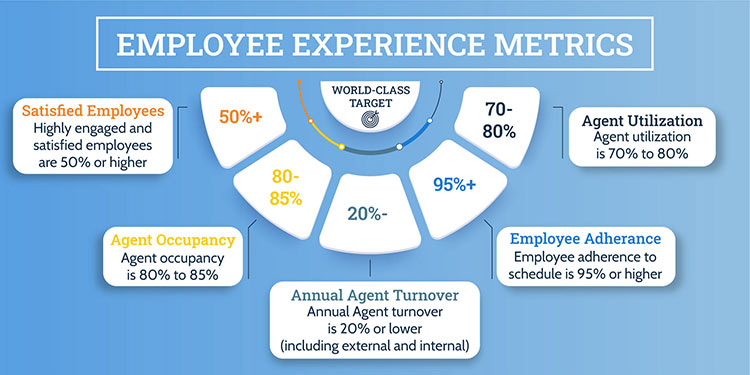
Quick Related Links
First Call Resolution Definition First Call Resolution PPT First Call Resolution Benefits
First Call Resolution Strategies First Call Resolution Operating Philosophy FCR Case Study Survey Data Calculate First Call Resolution Top 10 CX Metrics VoC Closed-Loop Outside-in or Inside-Out Journey Mapping Customer Service
